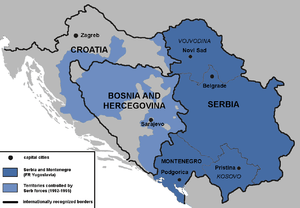United Serb Republic
| United Serb Republic | |||||||||||||
|---|---|---|---|---|---|---|---|---|---|---|---|---|---|
| 1995–1995 | |||||||||||||
 Flag
 Coat of arms
| |||||||||||||
|
Motto: Only Unity Saves the Serbs | |||||||||||||
 United Serb Republic (Light blue) and FR Yugoslavia (dark) (Serb territories) | |||||||||||||
| Status | Unrecognized state | ||||||||||||
| Common languages | Serbian | ||||||||||||
| Religion | Serbian Orthodoxy | ||||||||||||
| Government | Confederation | ||||||||||||
| President | |||||||||||||
| Legislature | National Assembly | ||||||||||||
| Historical era | Yugoslav Wars | ||||||||||||
• Assembly | May 1995 | ||||||||||||
| August 7 1995 | |||||||||||||
| Currency | Krajina and Republika Srpska dinar | ||||||||||||
| |||||||||||||
The United Serb Republic[a] also known as the West Serbian Federation was a project of unifying into a single independent state, two self-proclaimed Serb states, the Republic of Serbian Krajina (RSK) in Croatia and Republika Srpska (RS) in Bosnia and Herzegovina (BiH), with the intent of it later being annexed by the "mother-state of Serbia".[1]
History
On 28 February 1991, the Croatian Serbs declared their secession from Croatia[2] and adopted a resolution declaring their desire to unite with Serbs in Serbia, Montenegro, and Bosnia and Herzegovina.[3] On 27 June, the unification of the self-proclaimed Serbian Autonomous Oblasts (SAOs) of Krajina in Croatia and Bosanska Krajina in Bosnia and Herzegovina was declared in response to the "disintegration of Yugoslavia, caused by the secession of Slovenia and Croatia" and on "the principle that all Serbs should live in one state."[4] On 24 October, the SAO Eastern Slavonia, Baranja and Western Syrmia joined the united state.[5] The Bosnian Serb Assembly organised a referendum on 10 November 1991, which concluded that the Serb people in Bosnia and Herzegovina would remain in a Yugoslav state with Serbia, Montenegro and the SAO's.[6]
On 26 December 1991, Serbia, Montenegro, and the Serb rebel-held territories in Croatia agreed that they would form a new "third Yugoslavia".[7] Efforts were also made in 1991 to include SR Bosnia and Herzegovina within the federation, with negotiations between Milošević, Bosnia's Serbian Democratic Party, and the Bosniak proponent of union – Bosnia's Vice-President Adil Zulfikarpašić taking place on this matter.[8] Zulfikarpašić believed that Bosnia could benefit from a union with Serbia, Montenegro, and Krajina, thus he supported a union which would secure the unity of Serbs and Bosniaks.[8] Milošević continued negotiations with Zulfikarpašić to include Bosnia within a new Yugoslavia, however efforts to include the whole of Bosnia within a new Yugoslavia were effectively terminated by late 1991 as Alija Izetbegović planned to hold a referendum on independence while Bosnian Serbs and Bosnian Croats formed autonomous territories.[8] The independence referendum was organised unconstitutionally and it failed to attain the constitutionally required two-third majority voter turnout. The total turn out of voters was 63.4% of which 99.7% voted for the independence of Bosnia and Herzegovina. On 3 March, Chairman of the Presidency of Bosnia and Herzegovina Alija Izetbegović declared the independent Republic of Bosnia and Herzegovina and the parliament ratified the action. On 6 April, the United States and the European Economic Community recognized Bosnia and Herzegovina as an independent state and on 22 May it was admitted into the United Nations.
On 30 May 1993, an agreement on cooperation was reached between the Republic of Serbian Krajina and Republika Srpska.[9] On 20 June 1993, the Republic of Serbian Krajina held a referendum asking Serb voters if they supported unification with Republika Srpska asking: "Are you for the sovereignty of RSK, unification with RS and at a later date with the rest of the Serbian territories?".[9] It passed with "clear endorsement"[10] having 98.6 percent of voters who voted in favor.[9] Prior to this, Serb generals in Bosnia and Herzegovina and in Croatia formed a military alliance in the event that "Western Serbia" was attacked.[9] During 1994, further plans for the unification and creation of a "new republic of Western Serbia" were developed.[11] In late May 1995, the Parliament of the Republic of Serbian Krajina made the decision to unite with Republika Srpska.[12]
See also
Annotations
References
- ↑ Međimorec 2002, pp. 29-30.
- ↑ Ramet 2006, p. 383.
- ↑ Bethlehem & Weller 1997, p. xxvi.
- ↑ Bethlehem & Weller 1997, p. xxvii.
- ↑ Bethlehem & Weller 1997, p. xxxi.
- ↑ Bosnien-Herzegowina, serbischer Teil, 10. November 1991 : Unabhängige Serbische Republik in Bosnien-Herzegowina Direct Democracy
- ↑ Lukić 2005, pp. 55–56.
- 1 2 3 Burg & Shoup 1999, pp. 72–73.
- 1 2 3 4 Međimorec 2002, p. 171.
- ↑ Caspersen 2011, p. 117.
- ↑ Thomas 1999, p. 205.
- 1 2 Barić 2008, p. 97.
- ↑ Daily Report: East Europe. 200–210. FBIS. 1995. p. 28.
[Karadžić] We hoped that the United Serb Republic would have two seas:
Sources
- Barić, Nikica (2008). "The Rise and Fall of the Republic of Serb Krajina". In Ramet, Sabrina P.; Clewing, Konrad; Lukić, Reneo. Croatia since Independence: War, Politics, Society, Foreign Relations. Munich: Oldenbourg. pp. 89–106. ISBN 978-3-48658-043-3.
- Bethlehem, Daniel L.; Weller, Marc, eds. (1997). The 'Yugoslav' Crisis in International Law: General Issues. I. Cambridge: Cambridge University Press. ISBN 978-1-84545-726-6.
- Caspersen, Nina (2011). Contested Nationalism: Serb Elite Rivalry in Croatia and Bosnia in the 1990s. Oxford: Berghahn Books. ISBN 978-1-84545-726-6.
- Međimorec, Miroslav (2002). "The Medak Pocket". National Security and the Future. Zagreb: St. George Association. 3 (3–4).
- Ramet, Sabrina P. (2006). The Three Yugoslavias: State-Building and Legitimation, 1918–2005. Bloomington: Indiana University Press. ISBN 978-0-253-34656-8.
- Lukić, Reneo (2005). "From the Federal Republic of Yugoslavia to the Union of Serbia and Montenegro". In Ramet, Sabrina P.; Pavlaković, Vjeran. Serbia since 1989: Politics and Society under Milošević and After. University of Washington Press. pp. 55–94. ISBN 978-0-295-80207-7.
- Burg, Steven L.; Shoup, Paul S. (1999). The War in Bosnia-Herzegovina: Ethnic Conflict and International Intervention. M.E. Sharpe. ISBN 978-0-7656-3189-3.
- Thomas, Robert (1999). Serbia under Milošević: Politics in the 1990s. London: Hurst & Company.